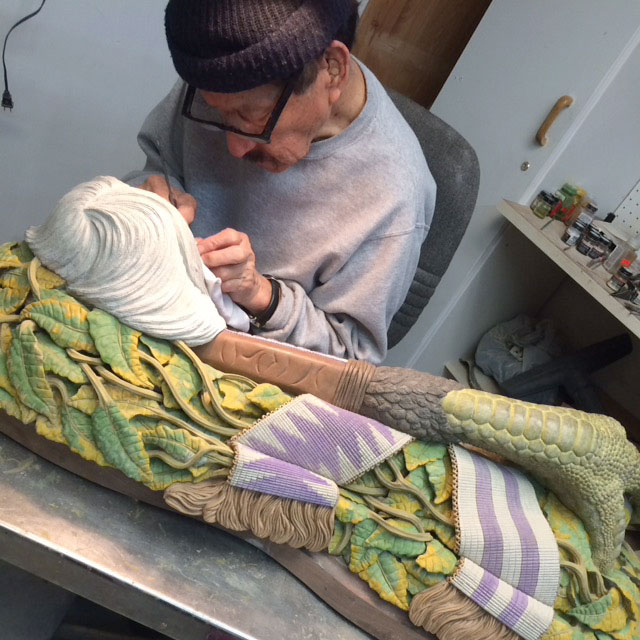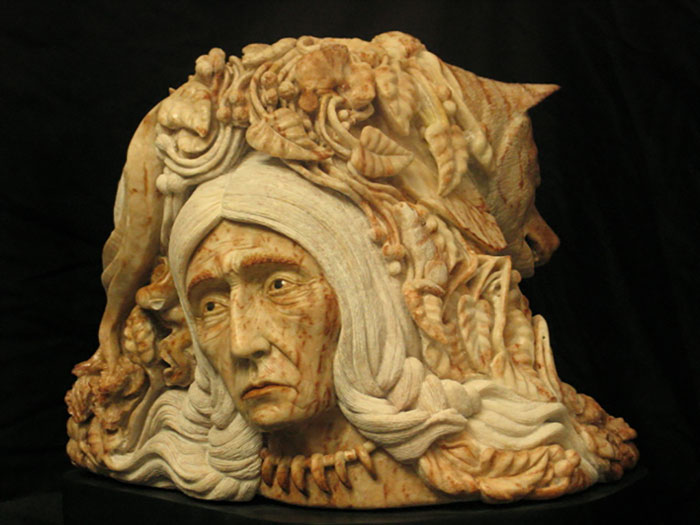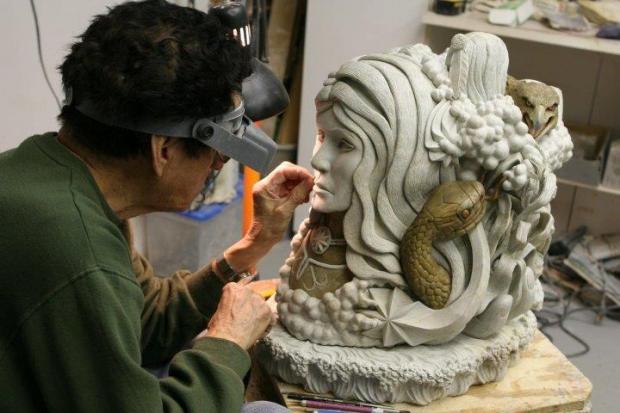Joseph Jacobs: Narratives in Stone
Every time the elected members of Canada’s parliament enter the House of Commons, they walk past Creation, a limestone frieze by the sculptor Joseph Jacobs, who died last week at his home on the Tuscarora Reservation just north of Niagara Falls.
The work is a bas-relief in Indiana limestone. It consists of three horizontal panels abutted on either end by verticals. It is Iroquois allegory that is, one can safely assume, incomprehensible to most of the Canadians who see it, even if they are Native Canadians.
Here’s why it’s different from the other pieces of contemporary Native Canadian art that adorn that vestibule, and here’s why it’s opaque: Iroquois iconography is specific, complex, and connected to extensive oral narratives that pierce longstanding European boundaries between religion and history. Creation, the frieze at the Canadian Parliament, is also exegesis and a political statement, at the same time that its presence is a challenging assertion of the permanence of a very specific culture that continues to evolve. What Jacobs did, less than 10 years into his career as an artist, was to execute a version of the Iroquois creation myth in stone in a way that has had a ripple of consequences for Iroquois cultural identity—an identity that carries on in a parallel, largely family-centered world in Upstate New York, Eastern Ontario, and Southern Quebec. It’s a world that is largely invisible to outsiders, even when one of its foremost artistic interpreter’s work is on very public display.
Tradition and the individual talent
Jacobs’s innovation was to create sculptures that comprehended the most complex of Iroquois narratives into single works. The pieces he created, mainly in stone, are complex, though most are not larger than three feet square. Executing them required months of exacting work with various hand-tools; according to some observers, he alternately amused himself or played a sculptural toccata by carving miniature figures in some of the recesses of his larger pieces. Had it not been for the patronage of Joseph “Smokin’ Joe” Anderson, the Tuscarora entrepreneur who endows the Native American Museum of Arts (NAMA) on Route 31 across from Niagara Wheatfield High School in Sanborn, economic necessity might have forced Jacobs to have continued in the longstanding Iroquois tradition of carving small objects—if not for the tourist trade, then for quick sale at galleries or art fairs.

Most cultures carve. It’s a commonplace for settled peoples. Not surprisingly for a people whom archaeologists say have dwelt in this same part of the world for at least a millennium, Iroquois carvers of wood, bone, and stone have been at it for a very long time here. Items of religious significance that are carved anciently and currently include the famous False Face masks; though there is considerable variation among them, there is continuity with ancient forms, and the post-contact change in tools from stone to metal did not change the practice of calling the images out from living basswood trees before they are removed for human use.
In very brief discussions with Jacobs’s relatives and with Dr. Percy Abrams, director of NAMA, the names of other carvers come up—including the late Duffy Wilson, who helped organize the now-abandoned Turtle building in downtown Niagara Falls, which was a showcase for Iroquois art for a decade before it closed. Anthony F. C. Wallace, whose 2013 book Tuscarora briefly mentions Jacobs, cites 18th-century accounts of formidable carvers among the Tuscarora, the sixth of the Six Nations. The late William Fenton, who worked on Iroquois subjects his entire professional life, spoke Seneca well, and founded the annual Iroquoia conference, described the late renowned carver Avery Jimerson’s rise to prominence as a religious leader and a musician, but also as a carver of False Face masks.
That’s the tradition from which Jacobs emerged. His achievement, though, was consequential in three ways. First, he focused on traditional narratives as integrated wholes, rather than pulling one or another figure out of a narrative and letting it stand alone. Second, his shaping of those narratives demonstrates his own complex cultural context. Third, he used the vocabulary of Iroquois cosmology in some pieces to argue, as it were, for a new interpretation of the place of art in Iroquois identity.

This is art within a cultural, religious, historical, linguistic, and political context. There are indeed abstract forms, evocations, references among the representations of mythical beings, animals, trees, plants. An adequate analysis of Creation would require some discussion of how it is that Jacobs decided to include two versions of the twins Sapling and Flint, whose renderings at either end of the piece evoke alternately False Face images and the Skywoman story. And what it means that he made the image of Tadodaho central to the piece—not the reformed Tadodaho whose penis had been cut down to size, whose kinks had been ironed out, whose snakes had been combed from his hair, but the unreformed Tadodaho, the Tadodaho whom the Peacemaker and Hayowentha struggled to convert from his evil ways to the new way, the Great Law of Peace.
Was Jacobs telling Canadians, in the mid-1980s when Canadian national unity was questionable, that even the Tadodaho’s power could be harnessed for an enduring peace?
Versions of creation
It’s probably not knowable whether anyone on Parliament Hill knows what those images have signified, or what the narratives of the Iroquois creation story and Great Law have come to mean to the folks who still tell them. But despite a collapse in the population of Six Nations people who speak the closely related Mohawk, Onondaga, Oneida, Cayuga, and Seneca languages, or the sharply divergent Tuscarora language, the narratives persist.
You wouldn’t know it to be so by going to Smokin’ Joe’s, but what happens inside the place is not only commerce but a forceful cultural revitalization movement that includes a quietly heroic effort to persist in keeping narrative, language, and metaphor fresh and vital.
Smokin’ Joe’s place sells biker gear and discount clothing. It sells tax-free cigarettes made in a native-owned factory. It sells groceries in a retail atmosphere that feels more like Price-Rite or Save-A-Lot than Wegmans, and it has a café that is a family diner with a truck-stop menu. The logical route for a visitor from Toronto or Buffalo is a drive across the Town of Niagara past tracts of modest split-level and modified Cape Cod homes, a formerly agricultural plain that began to be developed in the 1960s for homes for workers at the Delphi auto parts plant a few miles east in Lockport, at the chemical plants along the Niagara River, and at the waste-disposal sites that include places where Manhattan Project debris is stored. Many current households are dependent on the outlet mall just off the Thruway. The Tuscarora reservation itself is just north of Smokin’ Joe’s.
At the art museum just off the diner is a large body of Joseph Jacobs’s work. The graphic art by Simon Brascoupe, also from Tuscarora, may be more immediately approachable than the collection of sculptures on display at NAMA. At the National Museum of the American Indian on the National Mall in Washington, DC, contemporary native art is what gallery-goers these days are accustomed to: It’s themed, it’s abstract, it’s in the vocabulary that educated people around the world have grown used to. Brascoupe’s work is handsome and accomplished. It is the kind of graphic art that a discerning collector could comfortably locate near other works with a 20th-century sensibility.
Jacobs’s work is quite different. It is not, for the most part, abstract. It is not really for outsiders any more than altarpieces at medieval churches were executed for non-Christians, no matter how exquisite the artistry. The 2009 piece Skywoman looks like a jumble of naturalistic representations—a female face, an eagle, a snake, clouds, maize, some other plants, the fingers of a large hand, various other animals, strange little humanoid figures—all nicely executed, to be sure, by somebody competent with carving tools. But it is hard for an outsider to categorize. Just back from the Jean-Michel Basquiat exhibit at the Art Gallery of Ontario, which had a big space next to the luscious curves of Henry Moore sculptures, just around the corner from the Candian-identity gallery where the Group of Seven impressionists are gathered, this particular collection of contemporary art is from another sensibility entirely.
And without the narratives of Iroquois mythology; without the creation story; without knowing about the places of clan animals, dreams, certain plants, andwind; without knowing about the English-language commonplaces for mythological characters like Sapling and Flint, like the Peacemaker; and without knowing why that man has snakes in his hair, Jacobs’s art makes little sense.
Does the presence of the hand below the figures in Skywoman indicate that Jacobs’s experience as a Tuscarora Baptist, married into the leading Tuscarora Baptist family, shaped his understanding of the myth? Versions of the Skywoman story differ, but what is common to them all is that she fell through the hole in the sky created when her husband (or her father) uprooted the light-tree. We know that her fall to this world was buffered by the wings of swans, or geese, or herons, and that she landed on the back of the great turtle, and that various animals dived into the vast water to bring mud up for her to make into the earth, which she spread by dancing the shuffling dance Iroquois women now perform. We know that her daughter, impregnated by the West Wind, gave birth the usual way to Sapling, the Good-minded, but died in birthing his twin Flint, the Bad-minded, who cut his way out of her body careless of her existence; and that from her corpse sprang the Three Sisters—Corn, Beans, and Squash—which are the three crops the Iroquois cultivated, and cultivate still. The versions of the myth vary, but Skywoman fell, gave birth on Turtle Island, took her dead daughter’s head to make the moon, watched her grandchildren finish the creation, then do battle—but not the Good versus Evil battle of Middle Eastern religions like Zoroastrianism or Christianity, but something else, something different we’d have to be schooled on. Jacobs, the enrolled Cayuga who grew up at Tuscarora, who signed his work with his enrollment number from the Canadian reservation where most Cayugas live, whose funeral was conducted by a Baptist minister (an Eel Clan Onandaga), was an English speaker from a Christian community. Is that why there’s a hand under Skywoman and all the other elements of her story?
Jacobs isn’t known to have undertaken any work on Iroquois subjects until his occupational life as a laborer ended, due to injury, in 1974, when he fell off the roof he was working on. A family member said that before his injury, Jacobs made model cars from kits, but exquisitely, with doors that opened and engine parts that moved. Another family member recalled that before he became a carver, he made model airplanes the way American boys did in the 1930s and 1940s, out of balsa wood and tissue paper. After the injury he turned to Iroquois subjects, and the precision and the scope of his work quickly distinguished him. He began selling pieces at the large and well-regarded Curve Lake gallery in the Kawartha Lakes region of Ontario in the late 1970s. He worked at a studio there, becoming known to a growing and evidently appreciative Canadian audience. When Speaker Jerome of the Canadian Parliament commissioned five Native artists for work for the Member’s Foyer in 1981, Jacobs was one of them.
Canadian honors
Jacobs received an honorary doctorate from Trent University in 1983. He received the Order of Canada in 1989. The parliamentary Speaker, a barrister from Sudbury who served under both Liberal and Conservative governments, included Jacobs’s work in a group of commissions that were all made in Indiana limestone, which is not native material for either the Inuit, the Cree, nor the Cayuga whose work adorns the grand foyer of the Canadian capitol.
That’s part of the story here, too. Official Canada began including Native expressions in earnest after the 1970s. Many Canadian leaders were strongly interested then in achieving a more formal breakaway from Great Britain, and in asserting a distinctly Canadian identity in law as well as in culture. In 1981, then-Premier Pierre Eliot Trudeau led the way to enacting the Constitution Act, which became law despite the refusal of Quebec to ratify it. The long conversation about Canadian national unity continued with difficulty in the 1980s, with the Meech Lake accords foundering in 1987 over objections from First Nations as well as Quebeckers, and two near-miss referenda on Quebec independence since then, and great difficulty, in the past couple of years, with national discussions about abusive forced acculturation at both Catholic-run and state-run boarding schools for natives—and more recently, exposure of massive corruption at some reserves, and anguish over Mob-like tough guys using reserves as bases of operation for cigarette-smuggling and other bad acts. But a frequent feature of that process has been outreach to, inclusion of, and attempted collaboration with minority voices, including those of what are variously termed Aboriginal or Native communities.
Jacobs’s memorial wake was held at a funeral home near the outlet mall. His obituaries appeared in the Niagara Gazette and in the Buffalo News, but his death wasn’t mentioned in the Toronto Globe and Mail, nor the Toronto Star, nor in the Ottawa papers. The 200 or so people from Tuscarora and surrounding areas filtered through the visitation, the form of which was Baptist, as he and many of the assembled identified as such. The Baptist minister spoke after an elderly woman explained the eagle-feather fan clutched by the deceased in his open casket, the feathers being from the wings of a bird known to them as the one that flies highest, to brush the face of the Creator. Perhaps there is a text of an oral Iroquois narrative about the role of eagles transporting prayers. Joseph Jacobs did not carve such a text. But he did do a version of Skywoman. He did a version of the creation story, the one that gets told in the periodic recitations of the Great Law that describe not only the creation of the world but also the creation of the Iroquois confederacy, at which event the Peacemaker and his ally combed the snakes out of Tadodaho’s hair, buried the hatchet or war-club under the white roots of the great pine, in doing so creating not only peace among the Iroquois but a 50-member governing body, the names of whose founding members live on as the titles of today’s leaders. Jacobs’s rationale for his work was this: “I want to give permanence in stone to the legends of my people.”
Bruce Fisher is visiting professor of economics and SUNY Buffalo State and director of the Center for Economic and Policy Studies.

